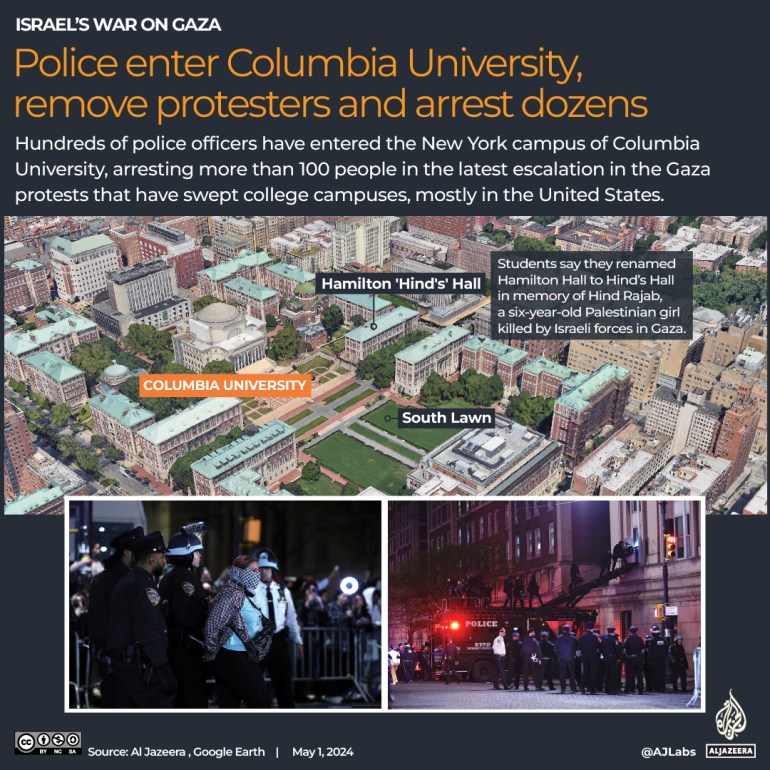Hamilton Hall, the Columbia University academic building that was occupied early April 30 by students protesting Israel’s war on Gaza, has a long history of student protests.
Over the past half-century, students have barricaded themselves there to protest pivotal moments in history, including the Vietnam War and growing global momentum against apartheid in South Africa.
Protesters named the building “Mandela Hall” in honor of the South African liberation leader during the 1985 student blockade. In a nod to the 1985 protests, students who took over the building on Tuesday named it in honor of six-year-old Hind Rajab, who was born along with her family by Israelis Killed by the armed forces in Gaza, he was rehoused in Hind’s Hall.
Police entered the campus on Wednesday morning and arrested dozens of people in the latest escalation between student, pro-Palestinian protests and law enforcement.
This crackdown, like the student takeover of Hamilton Hall, is consistent with the building’s history as an iconic protest site in Columbia.
What is Hamilton Hall?
The hall was inaugurated in 1907 as the flagship building and still houses the deanery today.
“This is a great day for the college,” Dean John Howard Van Amringe said at the time. “Our alma mater has a home of its own – a building more stately and beautiful, as it should be, more graceful and more significant than any other on the university’s grounds.”
An outdoor sculpture of Alexander Hamilton, who became the first Secretary of the Treasury in 1789 and the founder of the US banking system, proudly stands at the entrance. Hamilton is commonly portrayed as an abolitionist. However, some research suggests that his anti-slavery credentials may have been exaggerated.
In addition to four department offices – Germanic languages, Slavic languages, classical languages and Italian languages – it houses the Center on Race and Ethnicity.
A renovation that began in 2000 resulted in a new core curriculum center housing the Literary Humanities, Contemporary Civilization, Music Humanities, Arts Humanities, and Large Cultures departments.
When have Columbia students ever occupied Hamilton Hall?
1968: Protests in Vietnam
In April 1968, Hamilton Hall was the first of five buildings taken over by students protesting the Vietnam War.
Protesters barricaded themselves and prevented Acting Dean Henry Coleman from leaving his office for a night.
On April 30, a week after the protests began, police officers cracked down on demonstrators, entering the building through underground tunnels and forcibly evicting students.
More than 700 people were arrested, one of the largest mass arrests in New York City history. According to the student newspaper, at least 148 people were injured, some were beaten with batons and dragged out.
The protests led the university to cut ties with a Pentagon institute that conducted research on the Vietnam War and led to reforms favoring student activism.
1972: Anti-war protests
Protests erupted on campus again in the spring of 1972 as Richard Nixon’s administration expanded the U.S. military’s bombing campaign in Vietnam.
Protesters stormed into a closed session of the Columbia University Senate and forced its suspension after leadership called police to crack down on peaceful demonstrations.
The blockade of several campuses ended after police in riot gear stormed the site to disperse protesters.

1985: Anti-apartheid protests
A gathering of seven students that began at the entrance to Hamilton Hall on April 4 turned into a mass movement that lasted 21 days.
At that time, about a third of the university’s endowment money flowed into companies that did business in South Africa.
“America is not always right, but we have the right to protest for what is right,” civil rights activist Jesse Jackson told about 5,000 students on the steps of Hamilton. “If the nation of democracy becomes South Africa’s main trading partner, we are wrong, that is wrong.”
On October 7, about five months after the protests, Columbia became the first major U.S. university to completely separate from South Africa. Many others would follow.
1992: One-day blockade
In 1992, students blocked Hamilton Hall to stop Columbia’s plans to demolish the Audubon Theater and Ballroom, where Malcolm X was assassinated in 1965, and replace it with a modern biomedical research complex.
Malcolm After the shooting of Malcolm X, the venue was forced to close and the law was suspended for several years.
Columbia, the largest private landowner in New York City, purchased the Audobon Ballroom in the 1980s. In 1989, the university reached an agreement with city authorities to demolish the Audobon facility and build a biotechnology research center there.
Faced with demands to preserve the ballroom, Columbia eventually agreed to a compromise – only part of the historic venue would be demolished. However, student protesters opposed the demolition of the building.
The blockade lasted six hours: three students were suspended and 45 others faced disciplinary action.
1996: Department of Ethnic Studies
About 100 protesters occupied Hamilton Hall for about four days in 1996 to demand the creation of an ethnic studies department at Columbia.
The university agreed to provide physical space for Asian and Hispanic studies programs and opened the Center for the Study of Ethnicity and Race three years later.
